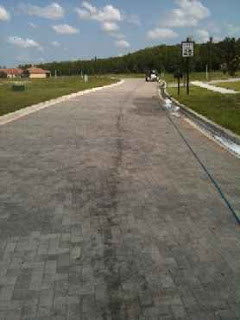

Oil stains on concrete can be a real problem. Whether it is on a roadway, driveway, restaurant drive-thru, bank drive thru, mall parking lot, parking garage, pavers, or whatever, - large or small, it can be an ugly mess!
Typical cleaners and degreasers will have some affect however, they don't go deep enough into the pores of the concrete to remove the black oil stains so only the surface of the oil is removed and a lasting stain remains - the results are usually less than satisfactory.
EATOILS™ BT200™ on the other hand, does go deep into the pores of the concrete to remove the oil residue and return the concrete to its original color.
EATOILS™ BT200™ is composed of natural surfactants, nutrients and beneficial microbes that target oils and grease with billions of tiny scrubbers to break down and digest the oils and other hydrocarbons and replace them with three harmless chemicals - oxygen, water, and carbon dioxide as a result.
Here's a testimonial from the Pressure Washing Institute's website Testimonials forum:
BT200™ and Pavers "I have been cleaning this one property’s front entrance area for about 4 years. They only clean it once a year. It has an area of red pavers (about 7500 sq. ft.), that when I got there 4+ years ago was totally wasted with leaked oil, a major stain as buses and cars park here. I told the manager back then - the best thing was to flip the pavers. He didn’t want to do that. I have cleaned the area 4 times with heavy duty degreasers and heat, but just didn’t get the stains out enough at all, I just made it better than it was. I was never happy with the finished product but the manager said it looked better. We would finish it but there were still some pretty black areas and then lighter stuff that looked okay."
"Well, this week I used EATOILS™ BT200™ on it and I have to say, it was a major difference and looked damn good, I'm pretty impressed."
"Before when we cleaned even when it was still wet you could see the oil stain. Last night we cleaned and wet areas and areas that had some time to dry out - you just couldn't see the stains that have been there for years. My guys and I were pretty surprised - and so was the maintenance guy. The stains were gone (if not 100%, certainly 90%) - it really looked good - a lot better than any other time we have cleaned. We went the night before and applied the BT200™ and went back last night and cleaned. I took some pictures but I want to go back when its 100% dry and take another look. But no matter what, it’s A LOT better."
NEXT DAY: "All I’ve got to say is WOW! After seeing how it looked last night, I really wanted to see how it looked the next day when it was dry, WOW!! As I was driving to take a look at it the property, the manager on property called to tell me how great it looked. I told him I would be there in a few minutes. Man, it looks 98% better than anytime I cleaned it before. (I did do something different on one 10x10 section last night. Where I had the BT200™ on a little area I X-jetted some Degreaser, the area wasn’t any cleaner than where I just put BT200™.)"
"Now on the pavers it is fantastic! There was some border area with a very smooth concrete and that is showing the stain shadow a little more than the pavers, but even that’s 85% cleaner than I ever got it before. This product even got in between the pavers really good - in the grooves there was no stain at all. Good stuff EATOILS™!" Testimonial from Jeff LeCours of JL PRESSURE WASHING of Myrtle Beach, SC.
For more information about this product click here.
We have a complete range of Green cleaning and treatment products. For further information about these products please visit our website or call us toll free at 866 621 8244 any time Monday - Friday 9:00AM - 5:00PM Eastern time.



